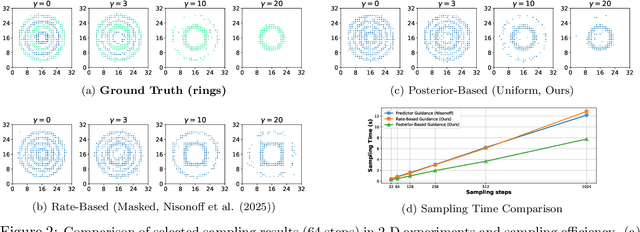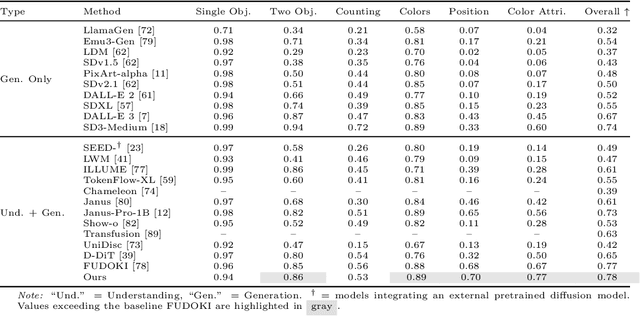Fang Fang
Peking University, China
MAD-Fact: A Multi-Agent Debate Framework for Long-Form Factuality Evaluation in LLMs
Oct 27, 2025Abstract:The widespread adoption of Large Language Models (LLMs) raises critical concerns about the factual accuracy of their outputs, especially in high-risk domains such as biomedicine, law, and education. Existing evaluation methods for short texts often fail on long-form content due to complex reasoning chains, intertwined perspectives, and cumulative information. To address this, we propose a systematic approach integrating large-scale long-form datasets, multi-agent verification mechanisms, and weighted evaluation metrics. We construct LongHalluQA, a Chinese long-form factuality dataset; and develop MAD-Fact, a debate-based multi-agent verification system. We introduce a fact importance hierarchy to capture the varying significance of claims in long-form texts. Experiments on two benchmarks show that larger LLMs generally maintain higher factual consistency, while domestic models excel on Chinese content. Our work provides a structured framework for evaluating and enhancing factual reliability in long-form LLM outputs, guiding their safe deployment in sensitive domains.
Discrete Guidance Matching: Exact Guidance for Discrete Flow Matching
Sep 26, 2025



Abstract:Guidance provides a simple and effective framework for posterior sampling by steering the generation process towards the desired distribution. When modeling discrete data, existing approaches mostly focus on guidance with the first-order Taylor approximation to improve the sampling efficiency. However, such an approximation is inappropriate in discrete state spaces since the approximation error could be large. A novel guidance framework for discrete data is proposed to address this problem: We derive the exact transition rate for the desired distribution given a learned discrete flow matching model, leading to guidance that only requires a single forward pass in each sampling step, significantly improving efficiency. This unified novel framework is general enough, encompassing existing guidance methods as special cases, and it can also be seamlessly applied to the masked diffusion model. We demonstrate the effectiveness of our proposed guidance on energy-guided simulations and preference alignment on text-to-image generation and multimodal understanding tasks. The code is available through https://github.com/WanZhengyan/Discrete-Guidance-Matching/tree/main.
Error Analysis of Discrete Flow with Generator Matching
Sep 26, 2025Abstract:Discrete flow models offer a powerful framework for learning distributions over discrete state spaces and have demonstrated superior performance compared to the discrete diffusion model. However, their convergence properties and error analysis remain largely unexplored. In this work, we develop a unified framework grounded in stochastic calculus theory to systematically investigate the theoretical properties of discrete flow. Specifically, we derive the KL divergence of two path measures regarding two continuous-time Markov chains (CTMCs) with different transition rates by developing a novel Girsanov-type theorem, and provide a comprehensive analysis that encompasses the error arising from transition rate estimation and early stopping, where the first type of error has rarely been analyzed by existing works. Unlike discrete diffusion models, discrete flow incurs no truncation error caused by truncating the time horizon in the noising process. Building on generator matching and uniformization, we establish non-asymptotic error bounds for distribution estimation. Our results provide the first error analysis for discrete flow models.
DNA-DetectLLM: Unveiling AI-Generated Text via a DNA-Inspired Mutation-Repair Paradigm
Sep 19, 2025Abstract:The rapid advancement of large language models (LLMs) has blurred the line between AI-generated and human-written text. This progress brings societal risks such as misinformation, authorship ambiguity, and intellectual property concerns, highlighting the urgent need for reliable AI-generated text detection methods. However, recent advances in generative language modeling have resulted in significant overlap between the feature distributions of human-written and AI-generated text, blurring classification boundaries and making accurate detection increasingly challenging. To address the above challenges, we propose a DNA-inspired perspective, leveraging a repair-based process to directly and interpretably capture the intrinsic differences between human-written and AI-generated text. Building on this perspective, we introduce DNA-DetectLLM, a zero-shot detection method for distinguishing AI-generated and human-written text. The method constructs an ideal AI-generated sequence for each input, iteratively repairs non-optimal tokens, and quantifies the cumulative repair effort as an interpretable detection signal. Empirical evaluations demonstrate that our method achieves state-of-the-art detection performance and exhibits strong robustness against various adversarial attacks and input lengths. Specifically, DNA-DetectLLM achieves relative improvements of 5.55% in AUROC and 2.08% in F1 score across multiple public benchmark datasets.
Energy-Efficient Design for Downlink Pinching-Antenna Systems with QoS Guarantee
May 20, 2025



Abstract:Pinching antennas have recently garnered significant attention due to their ability to dynamically reconfigure wireless propagation environments. Despite notable advancements in this area, the exploration of energy efficiency (EE) maximization in pinching-antenna systems remains relatively underdeveloped. In this paper, we address the EE maximization problem in a downlink time-division multiple access (TDMA)-based multi-user system employing one waveguide and multiple pinching antennas, where each user is subject to a minimum rate constraint to ensure quality-of-service. The formulated optimization problem jointly considers transmit power and time allocations as well as the positioning of pinching antennas, resulting in a non-convex problem. To tackle this challenge, we first obtain the optimal positions of the pinching antennas. Based on this, we establish a feasibility condition for the system. Subsequently, the joint power and time allocation problem is decomposed into two subproblems, which are solved iteratively until convergence. Specifically, the power allocation subproblem is addressed through an iterative approach, where a semi-analytical solution is obtained in each iteration. Likewise, a semi-analytical solution is derived for the time allocation subproblem. Numerical simulations demonstrate that the proposed pinching-antenna-based strategy significantly outperforms both conventional fixed-antenna systems and other benchmark pinching-antenna schemes in terms of EE.
PIG: Privacy Jailbreak Attack on LLMs via Gradient-based Iterative In-Context Optimization
May 15, 2025Abstract:Large Language Models (LLMs) excel in various domains but pose inherent privacy risks. Existing methods to evaluate privacy leakage in LLMs often use memorized prefixes or simple instructions to extract data, both of which well-alignment models can easily block. Meanwhile, Jailbreak attacks bypass LLM safety mechanisms to generate harmful content, but their role in privacy scenarios remains underexplored. In this paper, we examine the effectiveness of jailbreak attacks in extracting sensitive information, bridging privacy leakage and jailbreak attacks in LLMs. Moreover, we propose PIG, a novel framework targeting Personally Identifiable Information (PII) and addressing the limitations of current jailbreak methods. Specifically, PIG identifies PII entities and their types in privacy queries, uses in-context learning to build a privacy context, and iteratively updates it with three gradient-based strategies to elicit target PII. We evaluate PIG and existing jailbreak methods using two privacy-related datasets. Experiments on four white-box and two black-box LLMs show that PIG outperforms baseline methods and achieves state-of-the-art (SoTA) results. The results underscore significant privacy risks in LLMs, emphasizing the need for stronger safeguards. Our code is availble at \href{https://github.com/redwyd/PrivacyJailbreak}{https://github.com/redwyd/PrivacyJailbreak}.
Reliably Bounding False Positives: A Zero-Shot Machine-Generated Text Detection Framework via Multiscaled Conformal Prediction
May 08, 2025Abstract:The rapid advancement of large language models has raised significant concerns regarding their potential misuse by malicious actors. As a result, developing effective detectors to mitigate these risks has become a critical priority. However, most existing detection methods focus excessively on detection accuracy, often neglecting the societal risks posed by high false positive rates (FPRs). This paper addresses this issue by leveraging Conformal Prediction (CP), which effectively constrains the upper bound of FPRs. While directly applying CP constrains FPRs, it also leads to a significant reduction in detection performance. To overcome this trade-off, this paper proposes a Zero-Shot Machine-Generated Text Detection Framework via Multiscaled Conformal Prediction (MCP), which both enforces the FPR constraint and improves detection performance. This paper also introduces RealDet, a high-quality dataset that spans a wide range of domains, ensuring realistic calibration and enabling superior detection performance when combined with MCP. Empirical evaluations demonstrate that MCP effectively constrains FPRs, significantly enhances detection performance, and increases robustness against adversarial attacks across multiple detectors and datasets.
An Egocentric Vision-Language Model based Portable Real-time Smart Assistant
Mar 06, 2025Abstract:We present Vinci, a vision-language system designed to provide real-time, comprehensive AI assistance on portable devices. At its core, Vinci leverages EgoVideo-VL, a novel model that integrates an egocentric vision foundation model with a large language model (LLM), enabling advanced functionalities such as scene understanding, temporal grounding, video summarization, and future planning. To enhance its utility, Vinci incorporates a memory module for processing long video streams in real time while retaining contextual history, a generation module for producing visual action demonstrations, and a retrieval module that bridges egocentric and third-person perspectives to provide relevant how-to videos for skill acquisition. Unlike existing systems that often depend on specialized hardware, Vinci is hardware-agnostic, supporting deployment across a wide range of devices, including smartphones and wearable cameras. In our experiments, we first demonstrate the superior performance of EgoVideo-VL on multiple public benchmarks, showcasing its vision-language reasoning and contextual understanding capabilities. We then conduct a series of user studies to evaluate the real-world effectiveness of Vinci, highlighting its adaptability and usability in diverse scenarios. We hope Vinci can establish a new framework for portable, real-time egocentric AI systems, empowering users with contextual and actionable insights. Including the frontend, backend, and models, all codes of Vinci are available at https://github.com/OpenGVLab/vinci.
A Low-Complexity Placement Design of Pinching-Antenna Systems
Feb 20, 2025


Abstract:Pinching-antenna systems have recently been proposed as a new candidate for flexible-antenna systems, not only inheriting the reconfiguration capability but also offering a unique feature: establishing line-of-sight links to mitigate large-scale path loss. However, sophisticated optimization of the placement of pinching antennas has very high complexity, which is challenging for practical implementation. This paper proposes a low-complexity placement design, providing the closed-form expression of the placement of pinching antennas, to maximize the sum rate of multiple downlink users. Orthogonal multiple access (OMA) and non-orthogonal multiple access (NOMA) are both investigated when the pinching-antenna system is only equipped with a single antenna and only the OMA case is studied when there are multiple antennas equipped by the pinching-antenna system. Simulation results indicate pinching-antenna systems can outperform conventional fixed-antenna systems and are more suitable for large service areas.
Optimizing Value of Learning in Task-Oriented Federated Meta-Learning Systems
Jan 07, 2025



Abstract:Federated Learning (FL) has gained significant attention in recent years due to its distributed nature and privacy preserving benefits. However, a key limitation of conventional FL is that it learns and distributes a common global model to all participants, which fails to provide customized solutions for diverse task requirements. Federated meta-learning (FML) offers a promising solution to this issue by enabling devices to finetune local models after receiving a shared meta-model from the server. In this paper, we propose a task-oriented FML framework over non-orthogonal multiple access (NOMA) networks. A novel metric, termed value of learning (VoL), is introduced to assess the individual training needs across devices. Moreover, a task-level weight (TLW) metric is defined based on task requirements and fairness considerations, guiding the prioritization of edge devices during FML training. The formulated problem, to maximize the sum of TLW-based VoL across devices, forms a non-convex mixed-integer non-linear programming (MINLP) challenge, addressed here using a parameterized deep Q-network (PDQN) algorithm to handle both discrete and continuous variables. Simulation results demonstrate that our approach significantly outperforms baseline schemes, underscoring the advantages of the proposed framework.
 Add to Chrome
Add to Chrome Add to Firefox
Add to Firefox Add to Edge
Add to Edge